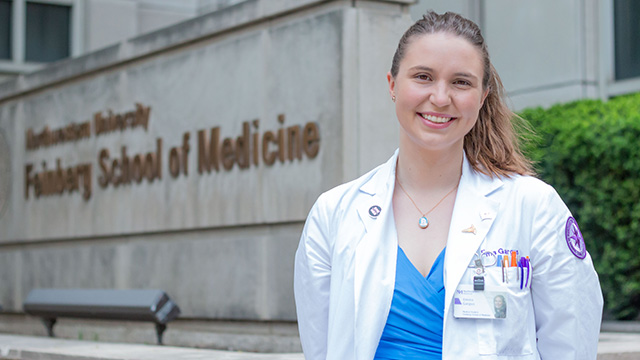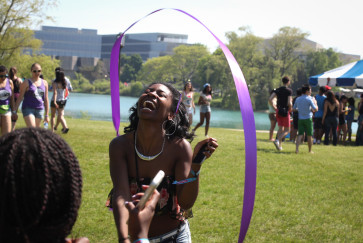This year, Northwestern University Feinberg School of Medicine and medical schools across the country are celebrating 75 years of partnership with the Veterans Health Administration.
Northwestern Now caught up with to two Feinberg trainees — Emma Susanna Gargus, who just completed her seventh year of Feinberg’s Medical Scientist Training Program (MSTP), and Russell Huang, ’17 MD, who just completed his ophthalmology residency at the McGaw Medical Center of Northwestern University and will be starting a glaucoma fellowship at Northwestern in July — about their experiences at the Jesse Brown VA Medical Center.
During their third and fourth year of medical school, Feinberg students have the option to complete some of their required clinical rotations — including surgery, psychiatry and medicine — at the Jesse Brown VA. McGaw residents can also choose to complete some of their training at the VA.
Gargus spent one month of her medicine rotation working at Jesse Brown, located near downtown in the Illinois Medical District, while Huang has trained there on and off for seven years.
Emma, what did you do at Jesse Brown?
I was at the VA for a month, completing one half of my required eight-week medicine rotation. I did the other half at Northwestern Memorial Hospital. The rotation consists primarily of patient care on the inpatient medicine floors, but we also had some lectures and conferences as part of the curriculum. My rotation at the VA was one of my favorite rotations in medical school. Working there is such great training because there are a lot of opportunities to take an active and meaningful role in patient care — even as a student.
Were you able to connect with patients in a meaningful way?
Yes. Even though my fellow students and I were busy calling consults from specialists or running down to the pharmacy to pick up prescriptions or getting daily weights or vitals for our patients, we also had a lot of time to sit down and talk with the patients and hear their stories about their time during and after service.
When chatting with a patient, I always asked what advice they have for trainees, as we're learning to become doctors, and to hear more about what qualities and behaviors they have liked and haven't liked from prior providers. The patients at the VA were so generous and thoughtful with their time and sharing their experiences. Obviously, patient care is the number one priority for clinical rotations, but once that was squared away, the veterans were really generous and patient, allowing me to practice physical exam maneuvers and other tasks to make sure I was learning everything I'll need in my future career.
Do you have a special tie to the military?
When I was in 5th grade, my grandparents moved in with me and my mom. My grandpa served in the Navy in World War II as a Seabee photographer in the Pacific Theater. He got all of his medical care at the VA and loved it. I was honored to have the opportunity to give back and provide that same care to other veterans.


